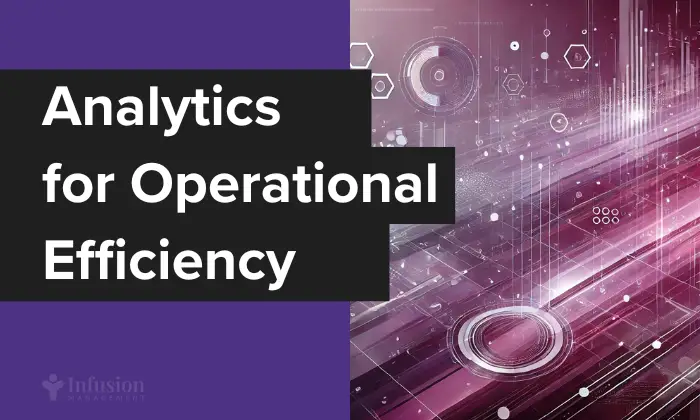Medical infusion practices face complex operational challenges including scheduling inefficiencies, variable treatment durations, resource utilization imbalances, and workflow bottlenecks that significantly impact both patient care and financial performance.
Advanced analytics solutions have emerged as powerful tools to address these challenges, offering data-driven insights that can transform infusion center operations.
From predictive scheduling algorithms that level-load patient appointments to real-time monitoring systems that track infusion pump utilization, analytics capabilities are helping practices reduce patient wait times, optimize staff workloads, improve resource utilization, and enhance overall operational efficiency.
The implementation of these analytics approaches has demonstrated significant improvements, with some facilities reporting up to 100% increases in nurse satisfaction regarding equitable workloads and substantial financial gains through reduced cancellations and improved operational efficiencies 75.
Understanding Operational Challenges
Infusion centers routinely encounter a range of operational challenges that impede efficiency and affect both patient and provider experiences. Many facilities struggle with a “triangular demand profile” where patient appointments cluster during midday hours, creating bottlenecks that result in extended wait times and overburdened staff during peak periods 8.
Traditional scheduling approaches often exacerbate these issues by treating each infusion chair as an independent resource rather than adopting a more flexible, pooled-resource approach that can better accommodate real-world variability in patient arrivals and treatment durations 8.

The complexity is further compounded by increasingly stringent pre-certification requirements, changing payer policies, drug shortages, and rising competition from private providers that create additional administrative burdens 5.
These challenges directly impact patient satisfaction through extended wait times, staff satisfaction through unbalanced workloads, and financial performance through suboptimal resource utilization and potential revenue leakage 5.
Infusion centers also face difficulties with cycle time management, as actual treatment durations frequently deviate from scheduled durations, causing cascading delays throughout the day 3. Less than 50% of infusion appointments start and end on time, creating ripple effects that disrupt carefully planned schedules and resource allocations 8.

These timing discrepancies stem from various factors, including provider differences in estimating treatment durations, patient-specific factors that affect administration times, and administrative delays in preparing medications or processing patients 3.
Without data-driven insights into these variations, infusion centers struggle to accurately schedule appointments, efficiently allocate resources, and maintain smooth patient flow throughout operating hours, ultimately compromising both operational efficiency and quality of care.
Real-Time Analytics for Fleet Management
Real-time analytics platforms offer infusion practices unprecedented visibility into their operations, enabling proactive management and continuous improvement of infusion pump utilization and performance.
DoseTrac Enterprise Infusion Management Software exemplifies this approach, providing real-time monitoring capabilities that track infusion pump usage across multiple facilities, generating actionable insights that help optimize resource allocation and identify operational inefficiencies 1.
These systems can monitor up to 40,000 pumps across an unlimited number of facilities using a single application, creating economies of scale for health systems while maintaining granular visibility into individual facility performance 1.
The comprehensive monitoring capabilities allow administrators to track key metrics such as drug library compliance, alarm-free infusion time, and alert reduction rates, which serve as important indicators of both operational efficiency and patient safety in infusion services 1.
The value of real-time analytics extends beyond monitoring to support continuous quality improvement initiatives that elevate infusion practice performance.
B. Braun’s approach combines technology with expert consultation, pairing their DoseTrac software with clinical consultants and data scientists who help facilities interpret data and implement improvement strategies 1.
This combination of technology and expertise helps transform raw operational data into actionable insights that drive positive outcomes in both efficiency and quality dimensions 1.
By measuring actual performance against benchmarks and targets, these analytics solutions help infusion centers assess their proficiency in technology adoption and identify opportunities for workflow enhancements, staff education, and resource optimization 1.
The real-time nature of these analytics allows for rapid identification of issues and timely intervention, creating a responsive operational environment that can continuously adapt to changing conditions and requirements.
Optimizing Scheduling

Predictive analytics represents a transformative approach to addressing one of the most persistent challenges in infusion services: optimizing appointment scheduling to balance resource utilization throughout the day.
Traditional scheduling methods typically result in uneven workloads with midday bottlenecks that create unnecessary wait times for patients and stressful peak periods for staff 8.
Advanced solutions like iQueue for Infusion Centers leverage machine learning algorithms to analyze historical patterns and predict optimal scheduling templates that can “level-load” appointments across the day, creating a more balanced workflow 2.
These predictive models consider multiple variables including appointment durations, staff availability, chair capacity, and historical patterns of patient flow to generate optimized scheduling templates that distribute workload more evenly 28.
The implementation of such predictive scheduling solutions has been shown to significantly improve operational metrics by reducing bottlenecks and enhancing resource utilization throughout the operating day.
The sophistication of these predictive analytics platforms extends beyond basic scheduling to address more complex operational challenges.
Some systems can proactively identify potential problem days by analyzing future scheduled appointments against historical patterns and available resources, allowing managers to take preventive action before issues materialize 2.
This predictive capability enables more proactive management of resources, potentially adjusting staffing levels or appointment schedules to accommodate anticipated high-volume periods 2.
The most advanced solutions move beyond traditional rules-based scheduling to employ true machine learning that continuously improves predictions based on actual outcomes, creating an increasingly accurate scheduling model that adapts to the specific patterns and needs of each facility 23.
By embracing these predictive analytics approaches, infusion centers can move from reactive management of scheduling problems to proactive optimization of resources, ultimately improving both operational efficiency and patient experience.
Cycle Time Optimization
Accurate understanding and management of treatment cycle times is fundamental to efficient infusion center operations, with analytics playing a crucial role in identifying and addressing discrepancies between expected and actual durations.

A recommended analytical approach begins with comparing expected durations to actual cycle times for each patient appointment, categorizing results into appointments that ran long, short, or within expected timeframes 3.
This baseline analysis can then be further refined by examining potential driving factors such as time of day, day of week, specific regimen, and ordering provider to identify patterns and root causes of timing variances 3.
Through this systematic analysis, infusion centers can uncover specific subsets of appointments that consistently deviate from expected durations—for example, discovering that a significant percentage of treatments scheduled for two hours actually require three-hour blocks—and adjust scheduling templates accordingly to better align with reality 3.
Time-of-day analysis offers particularly valuable insights for optimizing appointment scheduling and improving operational flow throughout the day.
Most infusion centers aim to schedule longer treatments earlier in the day to ensure completion before closing time, but without data-driven insights, these scheduling decisions may not account for the predictability or variability of specific treatment types 3.
Analytics can help identify which treatments have more predictable durations and can therefore be scheduled closer to the end of appropriate booking windows, versus those with greater variance that require more buffer time 3.
Provider-specific analysis represents another valuable dimension of cycle time optimization, helping to identify which providers consistently over or underestimate treatment lengths in their orders, potentially due to different methods of calculating treatment times or failure to account for preparation time 3.
By uncovering these patterns through data analytics, infusion centers can work toward standardizing treatment duration calculations and creating more accurate scheduling templates that reflect real-world conditions rather than theoretical estimates.
Key Performance Metrics
Establishing and tracking the right key performance indicators (KPIs) is essential for data-driven management of infusion practices, with metrics spanning operational, financial, and quality dimensions.
Industry experts emphasize the importance of defining “Metrics that Matter” that provide actionable insights for operational decision-making and performance improvement 5.
These metrics should address critical operational questions such as authorization timeliness, patient scheduling efficiency, chair utilization rates, referral sources, causes of patient leakage to competitors, and patterns of insurance denials 5.
Comprehensive analytics platforms like InfoDive integrate data from electronic health records (EHR) and practice management systems to evaluate productivity, financial performance, and quality metrics, enabling practice leaders to make data-backed decisions about resource allocation, staffing, and process improvements 6.
The most effective analytics approaches connect these metrics to specific operational goals and provide benchmarking capabilities that allow practices to compare their performance against industry standards or their own historical trends.
The implementation of robust analytics dashboards transforms raw data into accessible insights that can drive continuous improvement across the infusion practice.
Modern analytics solutions move beyond basic reporting to provide interactive visualizations and drill-down capabilities that allow users to explore patterns, identify root causes of issues, and model potential solutions 56.
These tools help bridge information gaps between different departments and roles, creating a shared understanding of performance across clinical operations, revenue cycle management, pharmacy, and administration teams 5.
When properly implemented, these analytics systems provide both high-level views of overall performance and granular insights into specific processes or problems, enabling both strategic planning and tactical problem-solving 6.
By centralizing these metrics in accessible dashboards, infusion practices create a culture of transparency and accountability where decisions are made based on evidence rather than assumptions, ultimately leading to more effective operational improvements and financial outcomes.
Workflow Integration and Automation
Integrated technology solutions that connect different aspects of infusion services represent a powerful approach to enhancing operational efficiency through streamlined workflows and reduced manual processes.
Solutions like IntelliDoseTxM exemplify this integrated approach by bringing together treatment plan management, computerized physician order entry (CPOE), nurse charting, and charge capture within a single system that interfaces with existing electronic health records 46.
This integration eliminates redundant data entry, reduces transcription errors, and ensures consistent information flow across all aspects of the infusion process from ordering through administration and billing 4.
By automating connections between previously siloed components of the workflow, these integrated solutions reduce the administrative burden on clinical staff, minimize potential points of failure in the information flow, and create more time for direct patient care activities 46.
The impact of such integration extends beyond efficiency to enhance patient safety by reducing the risk of medication errors, improving documentation compliance, and supporting standardized protocols across the practice.
Workflow automation specifically targets repetitive, rule-based tasks that traditionally consume significant staff time but add little clinical value.
Modern infusion management systems incorporate automation features that handle routine processes such as dose calculations based on patient parameters, preparation of standard orders based on protocols, automatic capture of charges based on administered medications, and generation of required documentation 46.
These automations not only save time but also reduce the risk of human error in critical processes that affect both patient safety and financial performance 4.
The most sophisticated systems adapt to the unique workflow requirements of each practice, providing configurable automation that aligns with established processes rather than forcing practices to conform to rigid, pre-defined workflows 6.
By localizing all aspects of treatment plan management into a single tool with built-in automation capabilities, practices can significantly reduce manual tasks, streamline operations, and redirect staff time toward activities that improve the patient experience and clinical outcomes 4.
Data-Driven Workload Distribution
Analytics-driven approaches to workload distribution have demonstrated significant impact on staff satisfaction in infusion centers, addressing one of the most common sources of nurse burnout and dissatisfaction.

The experience at Monroe Carell Jr. Children’s Hospital at Vanderbilt exemplifies this benefit, where the implementation of data-driven workload distribution tools led to a 100% increase in nurse satisfaction regarding equitable workloads and a 300% increase in satisfaction with the pacing of patient distribution throughout shifts 7.
This dramatic improvement stemmed from the adoption of iQueue for Infusion Centers’ Patient Assignment tool, which uses analytics to optimize the distribution of patients among available nurses while considering factors such as treatment complexity, timing, and nurse expertise 7.
The data-driven approach replaced subjective assignment methods that often resulted in perceived inequities or overwhelming workloads during certain periods, creating a more balanced and transparent distribution system that nurses recognized as fairer and more manageable 7.
The benefits of analytics-driven workload distribution extend beyond staff satisfaction to impact overall operational performance and patient experience.
Balanced workloads help prevent the burnout and turnover that plague many infusion centers, preserving institutional knowledge and reducing the costs associated with recruiting and training new staff 7.
More evenly distributed work also leads to more consistent patient care experiences, as nurses with manageable workloads can provide more attentive care without feeling rushed or overwhelmed by competing demands 7.
The implementation of these analytics-based approaches to staff assignment represents a particularly powerful example of how data can drive meaningful operational improvements in specialized healthcare environments like pediatric infusion centers, where patient needs are complex and unpredictable 7.
By empowering data-driven decision-making in staff assignments, infusion centers can create more sustainable work environments that benefit both caregivers and patients while supporting the overall efficiency and effectiveness of the practice.
Implementation Strategies

Successful implementation of analytics capabilities in infusion services requires a strategic approach that begins with building the right multidisciplinary team to guide the effort.
Industry experts recommend establishing an “infusion A-team” comprising stakeholders from specialty practice, infusion center operations, revenue cycle, pharmacy, managed care, and IT departments who can collaboratively address the multifaceted challenges of infusion services 5.
This multidisciplinary approach ensures that analytics initiatives consider the full spectrum of operational, clinical, and financial factors that influence infusion center performance 5.
The team must commit to working together toward shared goals of enhancing operational and financial performance while maintaining focus on patient care quality 5.
Leadership support is critical for these teams, as they need both the authority to implement changes based on analytical findings and the resources to sustain improvement initiatives over time 5.
By establishing this collaborative foundation at the outset, infusion practices can overcome the departmental silos that often impede effective use of analytics for operational improvement.
The technical implementation of analytics capabilities must address data integration challenges and establish appropriate infrastructure to support ongoing analysis and reporting.
Many infusion practices struggle with fragmented data sources, where critical information resides in separate systems for scheduling, clinical documentation, medication management, and billing 56.
Effective analytics implementation requires integration of these disparate data sources to create a comprehensive view of operations that spans the entire patient journey and captures all relevant operational metrics 5.
Leaders should recognize that existing reporting capabilities, such as standard EHR reports, often fall short in connecting these varied data streams and may need to be supplemented with more robust analytics platforms designed specifically for infusion management 5.
The implementation plan should include provisions for data validation to ensure accuracy, user training to build analytics capabilities across the organization, and continuous refinement of metrics and reports based on evolving operational needs 56.
By addressing these technical and organizational aspects of implementation, infusion practices can establish analytics capabilities that deliver sustainable value and support continuous operational improvement.
Summary
The application of analytics to infusion management represents a powerful approach to addressing the complex operational challenges that these specialized healthcare settings face.
The evidence from multiple implementations demonstrates that data-driven approaches can transform scheduling efficiency, resource utilization, staff workload distribution, and financial performance in infusion practices 257.
By moving beyond traditional, intuition-based management to embrace evidence-driven decision-making, infusion centers can create more balanced workloads, reduce patient wait times, optimize resource utilization, and ultimately improve both the patient and provider experience 38.
The most successful implementations combine technological solutions with organizational change management, creating multidisciplinary teams that can translate analytical insights into operational improvements 5.
As analytics capabilities continue to evolve, infusion practices have opportunities to further refine their approaches through increasingly sophisticated predictive models and machine learning applications that can address more complex operational challenges.
Looking forward, the integration of analytics into infusion management will likely expand to encompass more aspects of operations and create more seamless connections between different components of the infusion management workflow.
Future developments may include more advanced predictive capabilities that can anticipate and prevent operational issues before they occur, greater integration of patient-generated data to improve scheduling accuracy, and more sophisticated optimization algorithms that can balance multiple competing priorities simultaneously 28.
As healthcare continues to face resource constraints and financial pressures, the role of analytics in identifying efficiency opportunities will become increasingly important for maintaining financial sustainability while preserving quality of care 5.
By investing in analytics capabilities now and building the organizational culture and infrastructure to support data-driven decision-making, infusion practices can position themselves for success in an increasingly complex and challenging healthcare environment.
References
- https://www.bbraunusa.com/en/products-and-partnerships/smart-infusion/smart-infusion-pumps/dosetrac-enterprise-infusion-management-software-and-analysis.html
- https://www.hcinnovationgroup.com/whitepapers/whitepaper/53064470/optimizing-infusion-operations-through-predictive-analytics
- https://www.valuebasedcancer.com/issues/2020/april-2020-vol-11-no-2/2528:using-data-analytics-and-machine-learning-to-decode-cycle-times-how-infusion-centers-benefit
- https://www.specialtypracticenetwork.com/infusion-management
- https://www.linkedin.com/pulse/new-approach-outpatient-infusion-health-systems-brian-romig-9jyjc
- https://www.intrinsiq.com/infusion-practices
- https://leantaas.com/resource/empowering-change-through-data-driven-metrics-improving-nurse-satisfaction-at-monroe-carell-jr-childrens-hospital-infusion-center-at-vanderbilt/
- https://www.beckershospitalreview.com/hospital-management-administration/harnessing-data-science-to-revolutionize-infusion-center-scheduling/



